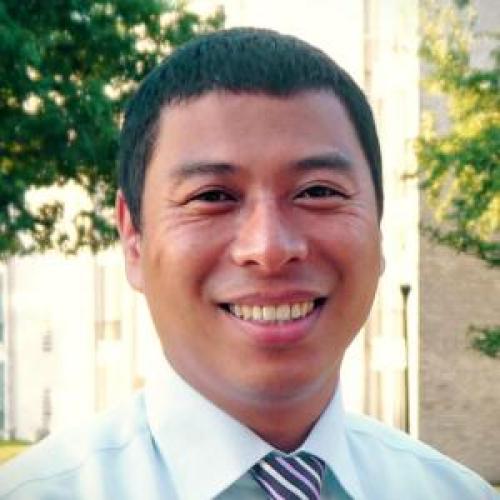Mechanical Engineering
Ph.D.
University of Maryland, College Park
2013

Dr. Hyung D. Bae received his B.S. M.S. degree in mechanical engineering of Yonsei University, Seoul, Korea, in 2004 and 2006, respectively, and a Ph.D. degree in mechanical engineering of the University of Maryland in 2013. He was a Research Assistant of the Mechanical Engineering Department at the University of Maryland from 2013 to 2016. He joined Howard University as a faculty in 2016. He was a nominee of A. James Clark School of Engineering fellowship from the University of Maryland (2008–2011) and is one of the inventors of U.S. patent, “Ultra-miniature fiber-optic pressure sensor system and method of fabrication”. He is a member of the American Society of Mechanical Engineers (ASME) and the Optical Society (OSA). His current research interests include polymer-based fiber optic sensors, bioinspired sensor systems, and 3D printed structures. Currently, he works on three funded-research projects on fiber optic sensors for chemical detection/biological sensing, and 3D printed pressure vessel.
Ph.D.
University of Maryland, College Park
2013
M.S.
Yonsei University, Seoul, Korea
2006
B.S.
Yonsei University, Seoul, Korea
2004
This course teaches students the fundamentals of MEMS (Micro-Electro-Mechanical Systems), MEMS applications, and various micro/nanofabrication processes. Students will also learn MEMS devices' design considerations such as molecular dynamics, fluid flows, and heat transmission in micro/nanoscale and materials for MEMS. Various microsystem fabrication processes will be introduced, such as photolithography, oxidation, chemical vapor deposition, etching, etc. Students will also learn how to collaborate with peers to design microsystems and present their ideas through the group project.
This course teaches students how to use commercially available Computer Aided Engineering software for multidisciplinary system design and optimization. With the acquired skill, students will be able to conceptualize complex engineering problems in virtual spaces and solve those by using CAE software (i.e., Fusion 360 and Simscale). Structural, generative design, thermal, heat transfer, and fluid dynamics analysis will be covered in the course with real-world engineering examples. Multiphysics FEM analyses will also be introduced in the class by coupling different analysis types to tackle challenging engineering problems. Students will learn how to work on a multiphysics design project in a team through online meetings, synchronous, and asynchronous communication tools (i.e., Slack and Blackboard).
This course teaches students how to create solid models, assemblies, and 2D drawings using Fusion 360 3D modeling software developed by Autodesk Inc. With the acquired skill, students will be able to design engineering parts/assemblies for machining, manufacturing, and 3D printing. Modeling and assembly of 3D design can also be used in future design classes in product design and various engineering simulations (structural, thermal, motion, multiphysics analysis, etc.). At the end of the course, Siemens NX12 will be introduced to students to broaden students’ 3D modeling skills.
DARPA
NSF
DOE
H. Bae, A. Giri, O. Kolawole, A. Azimi, G. Harris, A. Jackson (2019) “Miniature Diamond-Based Fiber Optic Pressure Sensor with Dual Polymer-Ceramic Adhesives”, Sensors Journal, Volume 19, Issue 9, pp. 2202, https://doi.org/10.3390/s19092202
Q. Dong, H. Bae, Z. Zhang, Y. Chen, Z. Wen, D. A. Olson, M. Yu, H. Liu (2019) “Miniature fiber optic acoustic pressure sensors with air-backed graphene diaphragms”, Journal of Vibration and Acoustics, Volume 141, Issue 4, pp. 041003, DOI: 10.1115/1.404
J. Ma, M. Zhao, X. Huang, H. Bae, Y. Chen, M. Yu (2016) “Low cost, high performance white-light fiber-optic hydrophone system with a trackable working point”, Optics Express, Vol. 24, Issue 17, pp. 19008-19019, DOI: https://doi.org/10.1364/OE.24.019008
J. Ma, X. Huang, H. Bae, Y. Zheng, C. Liu, M. Zhao, and M. Yu (2016) “Liquid Viscosity Measurement Using a Vibrating Flexure Hinged Structure and a Fiber-Optic Sensor”, IEEE Sensors, Vol. 16, Issue 13, pp. 5249-5258, DOI: 10.1109/JSEN.2016.2562740
Z. Zhang, Y. Chen, H. Liu, H. Bae, D. A. Olson, A. K. Gupta, M. Yu (2015) “On-Fiber Plasmonic Interferometer for Multi-Parameter Sensing,” Optics Express, Vol. 8, Issue 5, pp. 10732-10740, DOI: https://doi.org/10.1364/OE.23.010732
Y. Chen, H. Liu, M. Reilly, H. Bae, M. Yu (2014) “Enhanced acoustic sensing through wave compression and pressure amplification in anisotropic metamaterials,” Nature Communications, 5, Article number: 5247, DOI: 10.1038/ncomms6247
H. Kim, H. Bae, Z. Zhang , A. Kusimo, M. Yu (2014) “Optofluidic microvalve-on-a-chip with a surface plasmon-enhanced fiber optic microheater,” Biomicrofluidics, Vol. 8, Issue 5, pp. 054126, DOI: http://dx.doi.org/10.1063/1.4900978
R. Ganye, Y. Chen, H. Liu, H. Bae, Z. Wen, M. Yu (2016) “Characterization of wave physics in acoustic metamaterials using a fiber optic point detector”, Applied Physics Letters, Vol. 108, Issue 26, pp. 261906, DOI: http://dx.doi.org/10.1063/1.4955058
H. Bae, D. Yun, H. Liu, D. A. Olson, M. Yu (2014) “Hybrid Miniature Fabry–Perot Sensor with Dual Optical Cavities for Simultaneous Pressure and Temperature Measurements,” J. Lightwave Technol., Vol. 32, Issue 8, pp. 1585-1593
C. Pang, H. Bae, M. Yu, A.K. Gupta, M. Bryden (2013) “MEMS Fabry-Perot Sensor Interrogated by Optical System-On-A-Chip for Simultaneous Pressure and Temperature Sensing,” Opt. Express, Vol. 21, Issue 19, pp. 21829-21839, DOI: https://doi.org/10.1364/OE.21.021829
H. Bae and M. Yu, (2012) “Miniature Fabry-Perot pressure sensor created by using UV-molding process with an optical fiber based mold,” Opt. Express, Vol. 20, Issue 13, pp. 14573-14583, DOI: https://doi.org/10.1364/OE.20.014573